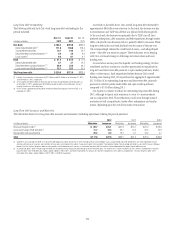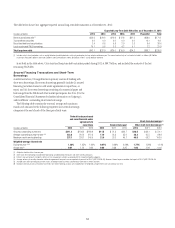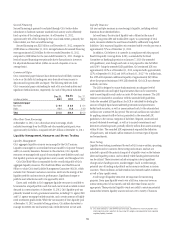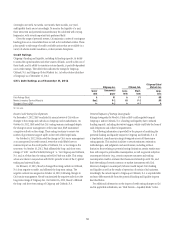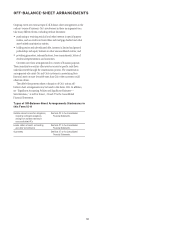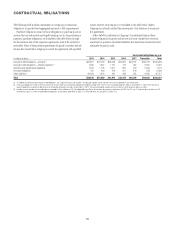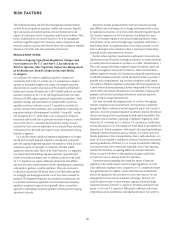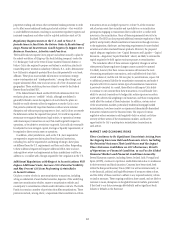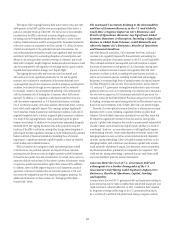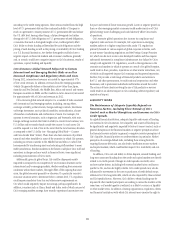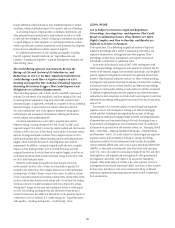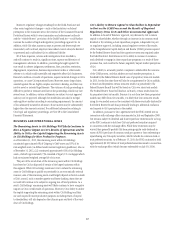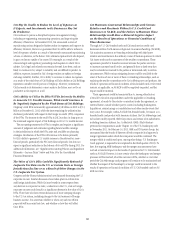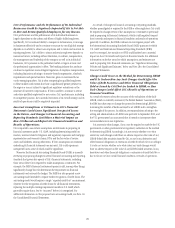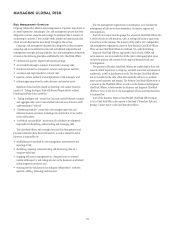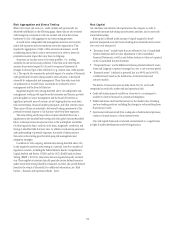Citibank 2012 Annual Report Download - page 85
Download and view the complete annual report
Please find page 85 of the 2012 Citibank annual report below. You can navigate through the pages in the report by either clicking on the pages listed below, or by using the keyword search tool below to find specific information within the annual report.63
proprietary trading and certain other investment banking activities in order
not to affect more traditional banking and retail activities—they would do
so under different structures, resulting in inconsistent regulatory regimes and
increased compliance and other costs for a global institution such as Citi.
Regulatory Requirements in the U.S. and in Non-U.S.
Jurisdictions to Facilitate the Future Orderly Resolution of
Large Financial Institutions Could Negatively Impact Citi’s
Business Structures, Activities and Practices.
The Dodd-Frank Act requires Citi to prepare and submit annually a plan for
the orderly resolution of Citigroup (the bank holding company) under the
U.S. Bankruptcy Code in the event of future material financial distress or
failure. Citi is also required to prepare and submit a resolution plan for its
insured depository institution subsidiary, Citibank, N.A., and to demonstrate
how Citibank is adequately protected from the risks presented by non-bank
affiliates. These plans must include information on resolution strategy,
major counterparties and “interdependencies,” among other things, and
require substantial effort, time and cost across all of Citi’s businesses and
geographies. These resolution plans are subject to review by the Federal
Reserve Board and the FDIC.
If the Federal Reserve Board and the FDIC both determine that Citi’s
resolution plans are not “credible” (which, although not defined, is
generally believed to mean the regulators do not believe the plans are
feasible or would otherwise allow the regulators to resolve Citi in a way
that protects systemically important functions without severe systemic
disruption and without exposing taxpayers to loss), and Citi does not remedy
the deficiencies within the required time period, Citi could be required to
restructure or reorganize businesses, legal entities, or operational systems
and intracompany transactions in ways that could negatively impact its
operations, or be subject to restrictions on growth. Citi could also eventually
be subjected to more stringent capital, leverage or liquidity requirements, or
be required to divest certain assets or operations.
In addition, other jurisdictions, such as the U.K., have requested or
are expected to request resolution plans from financial institutions,
including Citi, and the requirements and timing relating to these plans
are different from the U.S. requirements and from each other. Responding
to these additional requests will require additional effort, time and cost,
and regulatory review and requirements in these jurisdictions could be in
addition to, or conflict with, changes required by Citi’s regulators in the U.S.
Additional Regulations with Respect to Securitizations Will
Impose Additional Costs, Increase Citi’s Potential Liability
and May Prevent Citi from Performing Certain Roles
in Securitizations.
Citi plays a variety of roles in asset securitization transactions, including
acting as underwriter of asset-backed securities, depositor of the underlying
assets into securitization vehicles, trustee to securitization vehicles and
counterparty to securitization vehicles under derivative contracts. The Dodd-
Frank Act contains a number of provisions that affect securitizations. These
provisions include, among others, a requirement that securitizers in certain
transactions retain un-hedged exposure to at least 5% of the economic
risk of certain assets they securitize and a prohibition on securitization
participants engaging in transactions that would involve a conflict with
investors in the securitization. Many of these requirements have yet to be
finalized. The SEC has also proposed additional extensive regulation of both
publicly and privately offered securitization transactions through revisions
to the registration, disclosure, and reporting requirements for asset-backed
securities and other structured finance products. Moreover, the proposed
capital adequacy regulations (see “Capital Resources and Liquidity—Capital
Resources—Regulatory Capital Standards” above) are likely to increase the
capital required to be held against various exposures to securitizations.
The cumulative effect of these extensive regulatory changes as well as
other potential future regulatory changes cannot currently be assessed.
It is likely, however, that these various measures will increase the costs
of executing securitization transactions, and could effectively limit Citi’s
overall volume of, and the role Citi may play in, securitizations, expose Citi
to additional potential liability for securitization transactions and make it
impractical for Citi to execute certain types of securitization transactions
it previously executed. As a result, these effects could impair Citi’s ability
to continue to earn income from these transactions or could hinder Citi’s
ability to use such transactions to hedge risks, reduce exposures or reduce
assets with adverse risk-weighting in its businesses, and those consequences
could affect the conduct of these businesses. In addition, certain sectors
of the securitization markets, particularly residential mortgage-backed
securitizations, have been inactive or experienced dramatically diminished
transaction volumes since the financial crisis. The impact of various
regulatory reform measures could negatively delay or restrict any future
recovery of these sectors of the securitization markets, and thus the
opportunities for Citi to participate in securitization transactions in
such sectors.
MARKET AND ECONOMIC RISKS
There Continues to Be Significant Uncertainty Arising from
the Ongoing Eurozone Debt and Economic Crisis, Including
the Potential Outcomes That Could Occur and the Impact
Those Outcomes Could Have on Citi’s Businesses, Results
of Operations or Financial Condition, as well as the Global
Financial Markets and Financial Conditions Generally.
Several European countries, including Greece, Ireland, Italy, Portugal and
Spain (GIIPS), continue to experience credit deterioration due to weaknesses
in their economic and fiscal situations. Concerns have been raised, both
within the European Monetary Union (EMU) as well as internationally, as
to the financial, political and legal effectiveness of measures taken to date,
and the ability of these countries to adhere to any required austerity, reform
or similar measures. These ongoing conditions have caused, and are likely to
continue to cause, disruptions in the global financial markets, particularly
if they lead to any future sovereign debt defaults and/or significant bank
failures or defaults in the Eurozone.


